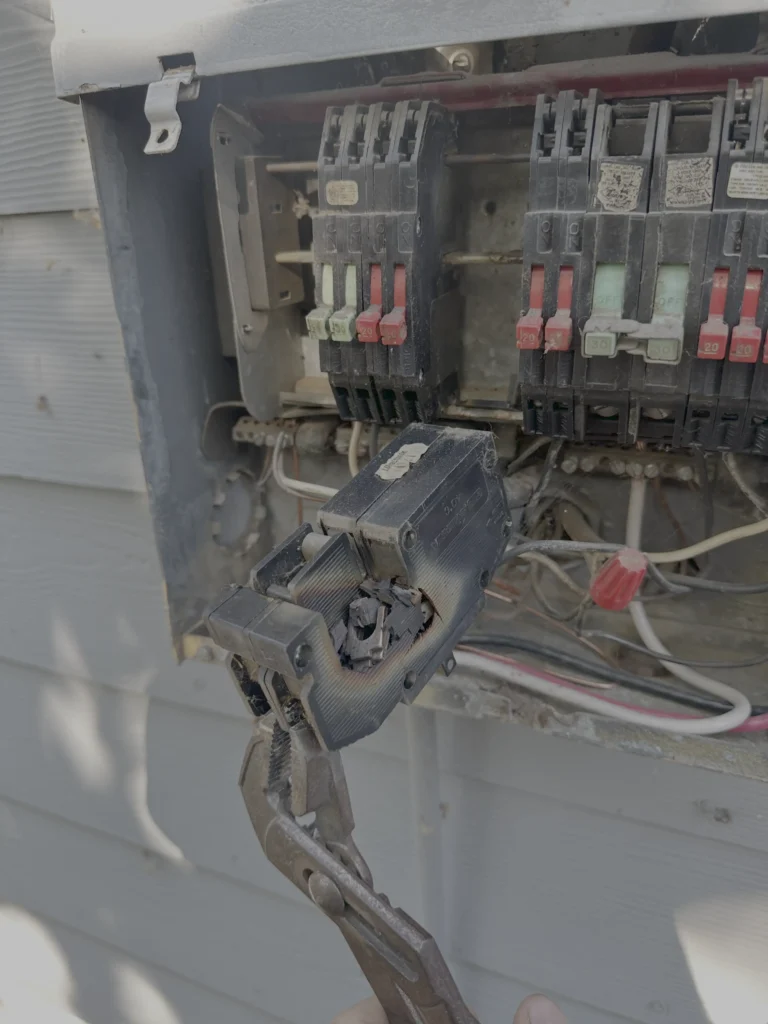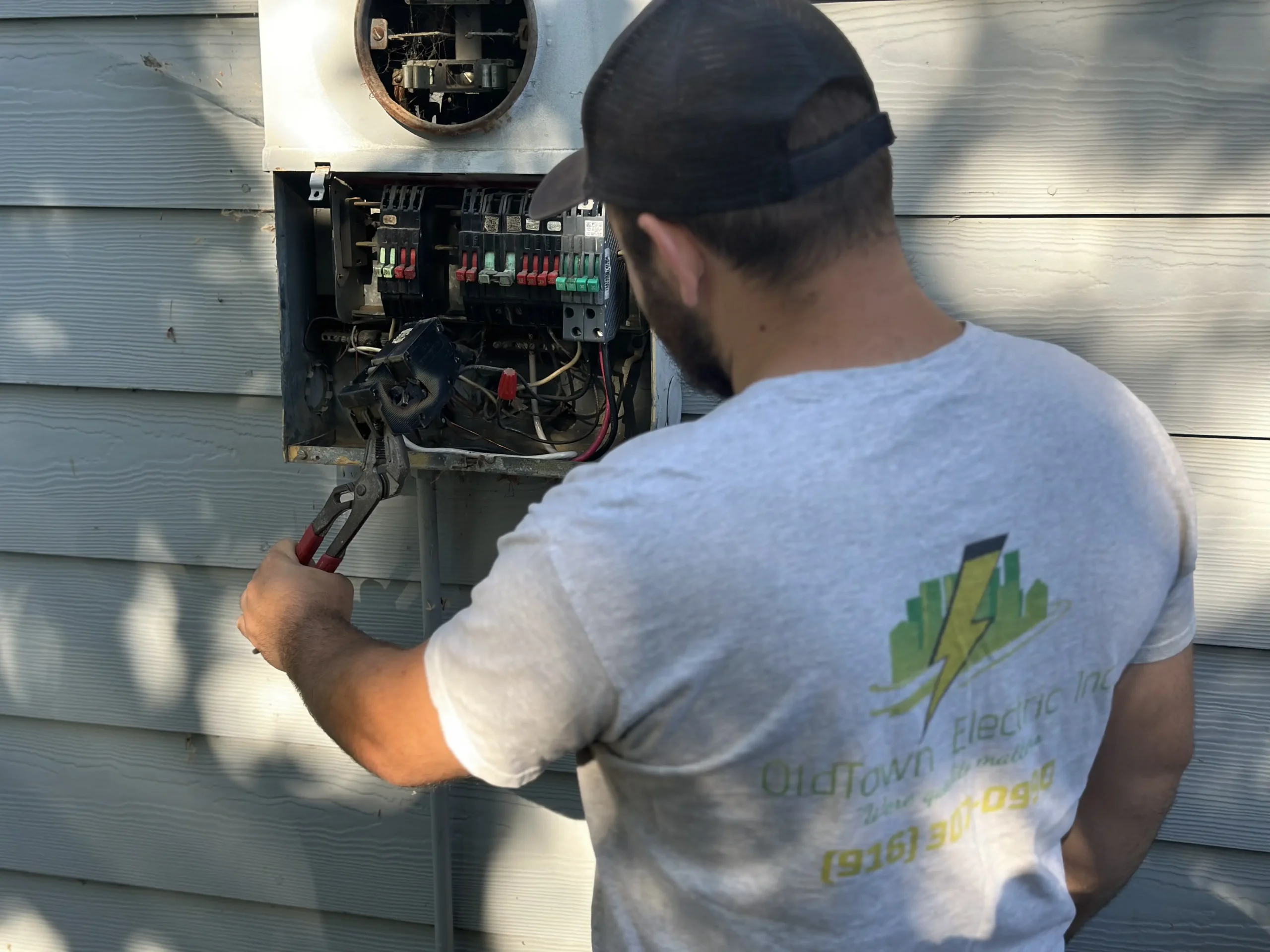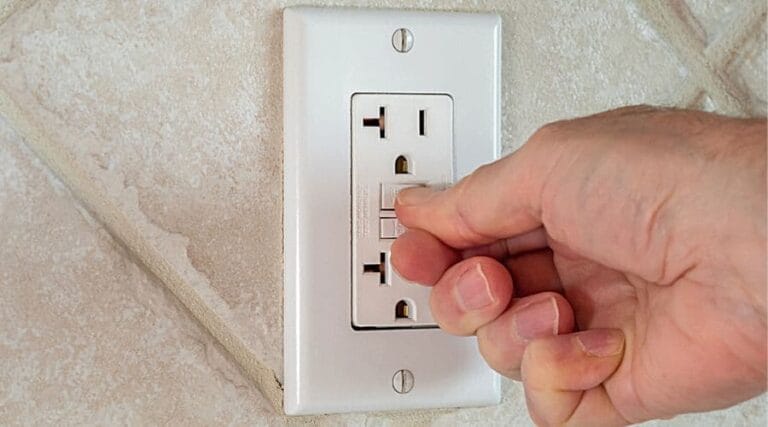Walk into any older home in Sacramento and you’ll probably see it: an electrical panel tucked away in the garage or laundry room. Most people ignore it until something goes wrong. Burned breakers. Tripped circuits. Flickering lights. At first, it feels like a small nuisance. But here’s the thing, these are often early warnings that your electrical panel is on its last leg. And waiting too long can be a costly mistake.
Table of Contents
Why Burned Breakers Are Never “Just Cosmetic”
If you’ve ever pulled open your panel door and spotted a blackened breaker, you know the sight can be unsettling. That charring doesn’t happen by accident. It’s heat damage—usually from loose connections, overloaded circuits, or outdated equipment that simply can’t keep up with today’s demand.
In my experience, homeowners often dismiss it. “It’s just one breaker,” they say. But a burned breaker is more than a minor blemish. It’s a fire hazard. Think of it like a worn-out tire. Sure, you can drive on it for a while. But every mile increases your risk of a blowout.
When breakers burn, they lose the ability to trip correctly. And if they don’t trip, they won’t stop an electrical surge. That’s when wires overheat. That’s when fires start.

The Hidden Cost of Tripped Circuits
We’ve all been there—too many appliances running, and suddenly, half the room goes dark. You flip the breaker back on and move along. But if you’re resetting breakers every week, that’s your panel telling you it’s overwhelmed.
Let’s be honest—modern life isn’t gentle on old wiring. Between big-screen TVs, laptops, chargers, refrigerators, and HVAC systems, today’s homes pull far more power than they did even 20 years ago. If your panel keeps tripping, it’s waving a white flag.
Here’s a quick comparison:
| Age of Home | Typical Panel Size | Modern Demand |
|---|---|---|
| Built before 1980 | 60–100 amps | Insufficient for most homes |
| Built 1980–2000 | 100–150 amps | Borderline with today’s usage |
| Built after 2000 | 200 amps | Meets demand, allows future growth |
If you’re still on an older 100-amp panel in Sacramento, you’re probably running it past its limit.
Sacramento’s Unique Challenges
Sacramento homes face particular stress because of summer heat. When temps hit triple digits, air conditioners run non-stop. That constant load is brutal on panels. Add in electric vehicle chargers, solar tie-ins, or backyard hot tubs—your electrical system might be pushed beyond design.
I’ve seen it firsthand. Last July, a homeowner in Elk Grove called after their panel started smoking. Their A/C, pool pump, and electric car charger were all running on a 125-amp panel. It wasn’t just tripping. Breakers were literally melting. We replaced the panel with a 200-amp upgrade, and they haven’t had a single issue since.
Signs You Need a New Electrical Panel
If you’re wondering whether your home is at risk, here are clear indicators:
- Breakers trip frequently, especially under normal use.
- Burn marks, rust, or buzzing inside the panel.
- Lights dim when large appliances kick on.
- Outlets feel warm or produce a burning smell.
- The panel is warm to the touch.
- You still have a fuse box instead of breakers.
- Insurance companies flag your panel as “unsafe.”
Any one of these should get your attention. Two or more? It’s time to call a licensed electrician.
Outdated Panels That Spell Trouble
Some panels are notorious for problems. If you’ve got one of these, replacement isn’t just recommended, it’s urgent:
- Zinsco Panels – Known for breakers that “stick” and fail to trip.
- Federal Pacific Electric (FPE) Panels – Linked to thousands of house fires due to defective breakers.
- Split-Bus Panels – Common in older Sacramento homes, now considered unsafe.
Truth is, these panels have been recalled or blacklisted by insurers. If you still have one, you’re gambling every time you turn on the lights.
What Replacement Really Involves
A lot of homeowners hesitate because they picture a massive, disruptive job. In reality, a panel replacement is usually completed in one day. Power is shut off, the old panel is removed, and a new one is installed with upgraded breakers.
Cost varies, but in Sacramento, most 200-amp replacements run between $2,500–$4,500+ depending on wiring, permits, and whether the utility service needs upgrading. It’s not cheap, but compare that with the cost of fire damage, or worse, and it’s easy to see the value.
Why DIY Isn’t the Answer
I’ll say it straight: electrical panels are not a DIY project. I’ve been called to jobs where homeowners tried swapping breakers themselves. One had wired a double-pole breaker backwards. It fried their dryer and nearly shocked them in the process.
Even seasoned handymen shouldn’t touch panels. Between code requirements, safety risks, and utility coordination, this is one of those jobs you leave to pros.
Future-Proofing Your Home
Replacing your panel isn’t just about solving today’s problem. It’s about preparing your home for tomorrow. With California moving toward all-electric homes and more Sacramento families adding EV chargers, demand will only rise.
A modern 200-amp panel gives you headroom. It allows for solar integration, larger HVAC systems, and future remodels without straining the system.
Think of it as upgrading from a flip phone to a smartphone. Your old phone might technically still make calls, but it’s painfully outdated for modern life.
Midtown Sacramento Upgrade
One of my recent jobs was a craftsman bungalow in Midtown Sacramento. Gorgeous home, but the original panel from the 1960s was still in place. Breakers tripped constantly whenever the homeowner ran her window A/C along with the microwave.
We installed a new 200-amp panel, added dedicated circuits for her appliances, and set up space for a future EV charger. She told me later she wished she’d done it years earlier—“The peace of mind alone was worth it.”
When to Call for Help
If you’re spotting burned breakers or dealing with regular tripped circuits, don’t ignore it. Panels don’t heal themselves. And in Sacramento’s heat, the risks only climb higher.
Your best step is to schedule a professional inspection. A licensed electrician can tell you if replacement is urgent, or if repairs and upgrades will buy you time.
Final Takeaway
Burned breakers and tripped circuits are more than small annoyances. They’re signals your electrical panel may be failing. And in Sacramento, where heavy summer loads push systems hard, ignoring those signals can be dangerous.
A new electrical panel isn’t just about safety, it’s about future-proofing your home, protecting your family, and keeping pace with modern life.
So if you’ve noticed the warning signs, don’t wait. Call a trusted Sacramento electrician today and get your panel evaluated.



